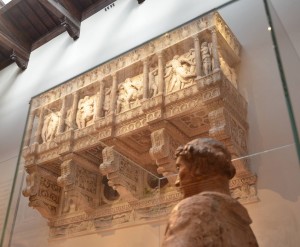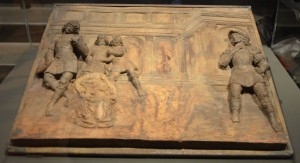Museo dell’Opera del Duomo, dal 21 ottobre 2016 al 26 febbraio 2017
Di Caterina Zaru (Università degli Studi di Firenze)
Il nuovo Museo dell’Opera del Duomo di Firenze ospita fino al 26 febbraio 2017 Donatello e Verrocchio. Capolavori riscoperti.
La mostra presenta, infatti, due grandi capolavori di due altrettanto grandi artisti del Quattrocento fiorentino: il busto in terracotta raffigurante San Lorenzo, attribuito a Donatello, e un rilievo, sempre in terracotta, che ha come soggetto della figurazione la Decollazione di San Giovanni Battista. Quest’ultimo ha stesso soggetto, dimensioni, composizione e costruzione prospettico-architettonica della scena commissionata ad Andrea del Verrocchio per lo straordinario Altare d’argento, un pezzo simbolo del patrimonio del Museo dell’Opera del Duomo, realizzato tra il 1366-1483 per il Battistero di Firenze, da più artisti, tra cui il Verrocchio stesso e Antonio del Pollaiolo, massimi esponenti della scultura fiorentina dell’epoca. Il rilievo esposto in mostra, quindi, sarebbe stato realizzato proprio nella bottega del Verrocchio.
A Francesco Caglioti, studioso ed esperto di Donatello, si deve la “riscoperta” (da qui il titolo della mostra) del busto di San Lorenzo. Risalente al 1440 circa, esso era destinato al timpano della porta maggiore della pieve a lui intitolata a Borgo San Lorenzo, nel Mugello, dove, infatti, rimase fino al 1888, quando l’antiquario Stefano Bardini (a cui oggi è dedicato l’omonimo museo di Firenze) lo acquistò, lasciando alla comunità “defraudata” una copia tuttora in situ. Questo per poi rivenderlo l’anno seguente al Principe Giovanni II di Liechtenstein. Nel 2003 gli eredi del principe misero in asta il San Lorenzo come opera ottocentesca e furono i coniugi Silverman, noti collezionisti di disegni, sculture e dipinti, ad aggiudicarsi l’opera. Negli anni successivi, rimossa la ridipintura ottocentesca, fu possibile ricostruire l’attribuzione a Donatello.
Comune anche all’altra opera esposta è una storia passata dalle vicissitudini piuttosto movimentate: essa venne trafugata dai nazisti durante la Seconda guerra mondiale, quale bottino di guerra che doveva poi andare a costituire il museo di Hitler a Linz.
Entrambe le opere, appartengono adesso alla Collezione Peter Silverman e Kathleen Onorato, informazione facilmente reperibile dalle didascalie che le accompagnano. Meno esplicito è invece l’intento della mostra, cioè quello di mettere in rapporto i due capolavori riscoperti con altre opere dei due artisti loro autori presenti all’interno del consueto percorso museale. Se, infatti, diretto è il rapporto tra il rilievo in terracotta con Decollazione del Battista e la stessa scena nell’Altare d’argento, perché le due opere sono state poste fisicamente l’una di fronte all’altra, molto meno chiaro risulta il collegamento tra il San Lorenzo e le altre opere di Donatello che con esso idealmente dialogano. La collocazione, pur prestigiosa ai piedi delle due Cantorie, realizzate da Donatello stesso l’una e da Luca della Robbia l’altra, non permette un confronto diretto con quelle figure realizzate da Donatello per la facciata del Duomo o per il Campanile, di cui il busto del Santo Lorenzo sarebbe il modello e che si trovano esposte nelle prime sale del museo, al piano terra. Donatello manifesta nell’opera in mostra quel misurato classicismo che ritroviamo, ad esempio, nel Profetino, o nel volto di Isacco del gruppo del Sacrificio o ancora nel giovane Profeta tradizionalmente riconosciuto come San Giovanni Battista. Evidente, però, è il rapporto con Luca della Robbia, proprio per i rimandi alla figurazione classica, rapporto che giustificherebbe la collocazione in mostra proprio tra le due Cantorie. Il bel disegno della bocca del San Lorenzo esprime tutta la forza interiore del Santo. I volti di Donatello, basti pensare ai simili tratti somatici del San Ludovico da Tolosa, del Gattamelata, del David marmoreo del Bargello, sono veri e propri specchi dell’anima. Qui un’anima pura e forte della fede religiosa che la guida, è incarnata in un busto tanto giovane e di una bellezza idealizzata, quanto orribilmente corrotta ma straordinariamente vera è l’anima e la figura della Maddalena che dal piano inferiore del museo sembra dialogare col San Lorenzo in questo evidente contrasto plastico-ideologico. Al contrario quindi, l’esposizione della Decollazione di fronte all’Altare d’ argento, permette, in un confronto ravvicinato, di capire se, effettivamente, il rilievo Silverman sia uno dei modelli preparatori della stessa scena poi realizzata nell’Altare dal Verrocchio e se, come è stato ipotizzato, vi si possa ravvisare l’intervento di Leonardo da Vinci, allora attivo nella bottega verrocchiana.
Purtroppo la mancanza di pannelli che mettano in evidenza i capolavori in mostra (le due opere si differenziano dal resto della collezione permanente solo per il colore, blu, delle loro didascalie, diverse dalle usuali, di colore bianco) e spieghino l’interessante e scientificamente rilevante intento della mostra, riduce la comprensione di esso alla sola “classe” privilegiata degli “addetti ai lavori”. L’unico strumento per comprendere a pieno la mostra è il bel catalogo edito da Mandragora con testi di Timothy Verdon, direttore del Museo dell’Opera del Duomo, e di Alessandro Vezzosi, direttore del Museo Ideale Leonardo Da Vinci.
Translation by: Rachyl Grussing
The new Works of the Duomo Museum hosts until 26 February 2017 Donatello and Verrocchio, Rediscovered Masterpieces.
Indeed, the show presents two grand rediscoveries of the two of the great artists of 14th century Florence: the terracotta bust representing Saint Lawrence, attributed to Donatello, and a relief by Verrocchio, also in terracotta, that has as the subject the figuration The Beheading of Saint Giovanni Battista. The latter has the same subjects, dimensions, composition and architectural perspective construction of the scene commissioned by Andrea Verrocchio for the extraordinary Silver Altar, a symbol of the heritage of the Works of the Duomo Museum, realized between 1366 – 1483 for the Florentine Baptistry, with more artists, including Verrocchio and Antonio del Pollaiolo, leading proponents of Florentine sculpture of the age.
Francesco Caglioti, a scholar and expert on Donatello, was responsible for the ‘rediscovery’ (hence the title of the show) of the bust of Saint Lawrence. Dating back to around 1440, it was intended for the lintel of the main door of the church of the neighborhood that bears his name, Saint Lawrence, in Mugello, where it remained until 1888, when the antiquarian Stefano Bardini (to whom today has a Florentine museum dedicated to his namesake) acquired, leaving the community ‘defrauded’ and a copy in its place. This then to sell it the following year to Prince John II of Liechtenstein. In 2003, the heirs of the Prince put in auction Saint Lawrence as a work of the 19th century and the Silvermans, known collectors of drawings, sculptures, and paintings, were the ones to win the work. In the next years, they removed the 19th century paint, to make possible a reconstruction of the work attributed to Donatello.
Also common in other works on display is a story of rather lively vicissitudes: it was stolen by the Nazi’s during the Second World War as spoils of war that was then going to be the Museum of Hitler and Linz.
Both of the works belong to the collection of Peter Silverman and Kathleen Onorato and information is readily available on them on the accompanying labels. Less explicit is the intention of the exhibition, that is, to put in context the two rediscovered works with other works by the artists already present within the usual museum tour. The relationship is direct between the reliefs in terracotta with the Beheading of Battista and the same scene in the Silver Altar, because the two works have been physically placed one in front of the other, much less clear is the connection between Saint Lawrence and the other works by Donatello that would ideally dialogue with it. The arrangement, while at the foot of the two prestigious Cantorie, one made by Donatello himself and the other by Luca della Robbia, does not allow a direct comparison with the figures by Donatello for the facade of the Duomo or for the Campanile, of which the bust of Saint Lawrence would be the model for and which guests find are displayed on the first floor, the ground floor, of the museum. Donatello manifested in the work of the show the measured classicism that we find, for example, in the Prophets, or in the face of Isaac in the group of the Sacrifice, or even in the young Prophet traditionally acknowledged as Saint Giovanni Battista. Clear, however, is the connection with Luca della Robbia, because of the references to classical figures, the relationship would justify the placement of the works in the exhibition between the two Cantorie. The beautiful design of the mouth of Saint Lawrence expresses all the Holy inner force. The face of Donatello, thinking of the similar physical features of Saint Ludovic of Toulouse, of Gattamelata, of the marble David in the Bargello, are true mirrors of the soul. Here the pure and strong soul of the religious faith is the guide, incarnated in the very young bust of an idealized beauty, how horribly corrupt but extraordinarily true is the soul of the figure of Mary Magdalene that from the lower floors appears to converse with Saint Lawrence in this evidently plastic ideology. Conversely then, the exhibition of the ‘Beheading’ in front of the Silver Altar permits a close conversation to actually understand that the Silverman relief is one of the preparatory models for the same scene realized in the Altar of Verrocchio, and if, as has been suggested, the intervention of Leonardo da Vinci can be recognized, then the activity happened in the shop of Verrocchio.
Unfortunately, the lack of panels highlight the evidence of the works on display (the two works are different from the rest of the permanent collection only for the color, blue, and their captions, different than the usual white color) and explain the interesting and considerable scientific intention of the exhibition, decreases the idea that it is only for the ‘privileged class’ of ‘experts’. The only tool for understanding fully the exhibition is the beautifully edited catalogue of Mandragora by Timothy Verdon, the director of the Works of the Duomo Museum, and Alessandro Vezzosi, the director of the Museo Ideale Leonardo da Vinci.

